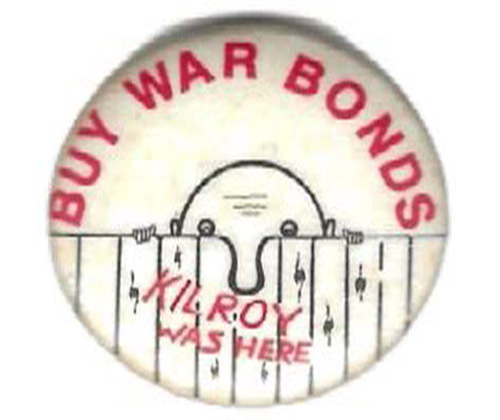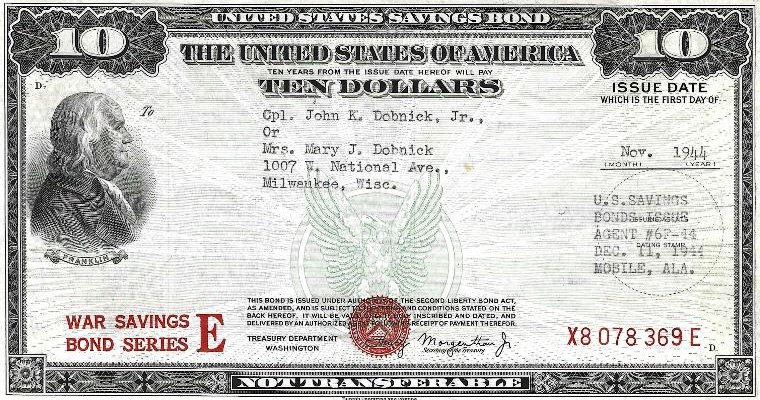
NOW Articles Written By Members
An Argument for Collecting Half Dollars
Late Night and a Russian Type Set
Old Country Coins: Newfoundland’s Rarest 5-Cent
Milwaukee Medals: Fifth Ward Constable
A look back at a common, but classic commemorative – Wisconsin’s Territorial Centennial
A side-tracked story: Mardi Gras Doubloons
A look back at a collecting specialty – the O.P.A. ration tokens of WWII
Bullion And Coin Tax Exemption – Act Now!
Is There A Twenty Cent Piece We Can Add To A Collection
Capped Bust Half Dollars: A Numismatic Legacy
U.S. Innovation Dollars: Our Most Under-Collected Coin?
My 2023 ANA Summer Seminar Adventure
>> More articles in the Archive
For more NOW Articles Written By Members,
Kilroy promotes war bond sales
[By Tom Casper #0982]
Many of the wars the United States has been involved in have resulted in the selling of bonds to the public to finance their costs. This was true for the Spanish American War, World War One, and World War Two. Before World War Two, the bonds were called savings bonds. As we neared the start of the conflict, they were renamed defense bonds, and, after Dec. 7, 1941, they became war savings bonds.
There was a huge advertising blitz by both the government and private industry during the war to promote bond sales to residents. Employers used payroll deductions and encouraged workers to spend 10 percent of their wages on bonds. War bond rallies were held throughout the country with war heroes and celebrities entertaining the crowds. The government had eight individual war loan campaigns to raise money throughout the war. Many magazines displayed bonds on their front cover as well as on ads inside. Bonds were promoted everywhere including matchbooks, window stickers, and postal cancellations.
Even the Boy Scouts assisted in bond sales.
The military personnel were not immune from buying bonds. The government, recognizing that troops had less money to spend than the civilian population during the war, issued a special bond for them. It was a $10 bond commonly referred to as a soldier’s bond. If you are fortunate to find one of these for your collection, the soldier’s rank will usually precede his name. The smallest denomination bond available for the civilian population to purchase was $25.

Shown above is a celluloid pinback button encouraging everyone to buy war bonds. The 31mm button reads “BUY WAR BONDS – KILROY WAS HERE.” On the back edge is “Wash. D.C. 1943.” Kilroy is also pictured. He is depicted as a bald man behind a wall with a large proboscis with his hands grasping the top of the wall. Perhaps you recognize Kilroy from the era. He was just EVERYWHERE.
When he wasn’t promoting bond sales, he accompanied U.S. troops overseas. We know he was there because wherever our troops landed, they saw the phrase “Kilroy was Here.” They found graffiti on buildings, bridges, bathroom stalls, clothing, in the holds of navy ships, on ordnance, and even on airplane nose art.
By now you are probably asking yourself who is Kilroy? The origin of Kilroy has been debated. In 1946, a contest was held to determine who originated the phrase. More than 40 candidates claimed to have crafted the doodle and motto.
There is one possible story on who may have started this. He was James J. Kilroy, an American shipyard inspector. He worked in a shipyard in Quincy, MA, during the war. Kilroy marked the work he had inspected and approved with the phrase “Kilroy was here” in durable crayon. But there is no firm proof this is the origin.
Kilroy is a mythical person. The phrase “Kilroy was here,” is a meme that became popular during the Second World War. A meme is an idea, typically humorous, that spreads from person to person within a culture. The graffiti was drawn by American troops in the Atlantic and later in the Pacific in addition. It was a universal sign American soldiers had come through an area and left their mark.
It was a widespread inside joke.
One story has it that German intelligence found the phrase on captured American equipment. This led Adolf Hitler to believe that Kilroy could be the name or code name of a high-level Allied spy. This was a long and deadly one and this saying was a morale booster. The phrase “Kilroy was here” was an emblem of pride that said no place and no country was beyond the reach of America’s might. “Kilroy was here” is written in two locations on the World War Two Memorial in Washington, D.C. Kilroy was here and will always be remembered and present.

Have an interesting numismatic topic you’d like to share with your fellow NOW members?
Send your article to evan.pretzer@protonmail.com today!!!